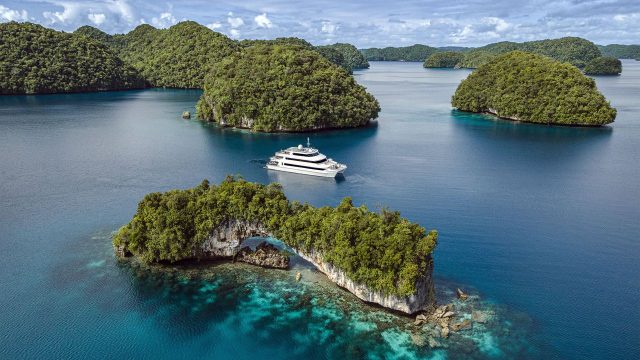
It was a journey full of firsts, as are most trips to the tiny Pacific nation of Palau. Before my first swim with jellyfish and my first leap from a paddleboard into an underwater cave, my passport had been stamped with its first entry visa that doubled as a conservation pledge. And before that, at Heathrow, I was checked in for the first time by an airline worker who had never even heard of my destination.
Why come here?

Palau consists of more than 300 islands, most of them uninhabited and many in the form of spectacular mushroom-topped domes. The unusual shape is the result of 40 million years of erosion. At sea level, between the high and low tide marks, windblown sand and waves wear away the limestone bedrock, undercutting the densely forested landscape above.
Beautiful though the islands are, the real draw lies below the waterline. Diving and snorkelling sites here include a diverse range of reefs, shipwrecks and even a downed Second World War fighter plane. The coral is in conspicuously good health too: natural variation in the local water temperature, and the acid-neutralising effect of the limestone, has made it more resilient to the bleaching events that have damaged other reefs.
Where to stay

For now, Palau is light on tourist infrastructure. Four Seasons will open a resort in the next few years, but until then it runs a floating boutique hotel aboard a catamaran that tours the islands. The Four Seasons Explorer is not only more flexible than a cruise ship – you can arrive or depart on any day of the week by speedboat shuttle – but also much smaller. With just 11 cabins, you can expect to be on first-name terms with fellow guests and crew alike.
Unless you have sprung for the Explorer Suite, spanning the full width of the boat, you will be in one of 10 small (20 square metres) but very comfortable staterooms. The beds are as luxurious as you would expect in a Four Seasons hotel, and three-times-daily housekeeping keeps everything ship-shape. High-speed wi-fi is included.
What to do

If it happens on, under or in the water, you can do it in Palau. Surfing is a bit of a stretch, given the glassy calm in the shallows around the islands, but (for an extra fee) the Explorer crew can arrange day trips out to breaks on the fringe of the archipelago. The rest of the activities are included in the nightly rate: diving, snorkelling, paddleboarding, kayaking, birdwatching and guided excursions onto the islands.
The variety of diving and snorkelling sites – and their spectacular surroundings – set Palau apart from other marine destinations. Three or four times a day, you will find yourself slipping into open water, wading onto a beach or sculling through a lazy river that winds its way through mangrove-clad fjords. With your mask on and your head under the water, you start to find the real Palau.
No two reefs are alike. At some, the main attraction is the corals and anemones that support these otherworldly ecosystems. At others, it’s the teeming shoals of fish: javelin-like barracudas skimming along the surface, giant humphead wrasse cruising deeper waters and in between, every colour, size and shape of sea creature you can imagine. The Pacific green turtles were a highlight, casting an untroubled eye in my direction as they drifted slowly past.
The jellyfish, though, were my strangest swimming companions. They’re found on the island of Mecherchar, in a highly unusual lake. Sheltered from wind by steep cliffs and almost (but not quite) cut off from the surrounding ocean, its waters have settled into two distinct layers. The upper zone is rich in oxygen and plankton, nourished by seawater that seeps in through fissures at high tide. Beneath is the dead zone, undisturbed and unrefreshed by rain or tide. At a depth of just 15 metres, oxygen levels drop to zero and clouds of deadly hydrogen sulphide drift through a lifeless world.
It’s an odd feeling to float above such treacherous waters, particularly in the presence of the football-sized golden jellyfish – even if they pose no threat. Having been cut off from ocean predators, they’ve lost almost all of their stinging power.

Eating and drinking
The food is consistently excellent, and surprisingly varied given the logistics involved. Fish is prominent – grilled, curried, steamed or served as ceviche – as are Asian and Pacific influences. The stand-out meal was a Japanese-themed menu of sushi followed by wagyu fillet, made all the more memorable for being served out on deck.
When to go

Palau is a year-round destination, with air and sea temperatures a consistent 28-30C. The wet season runs from May to December, but rain usually comes in short, dramatic showers between lengthier spells of sunshine.
Holden Frith was a guest of Four Seasons

A luxury Four Seasons catamaran is the ideal jumping-off point for the reefs, wrecks and coral islands of this unspoilt archipelago





